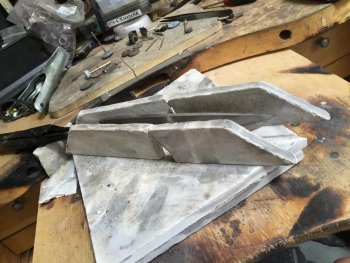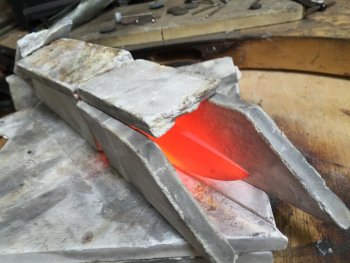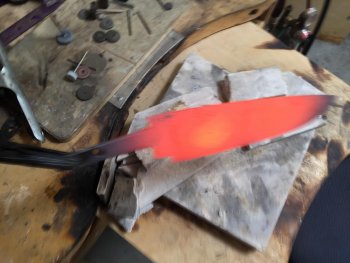Anyway, is there anything I can do to this knife to bring out the Hamon line that I can faintly see there? Is it really there and just not brought out or is it only barely there? Thanks for the help,
Wallace
Wallace you're going through the same thing I went through several years ago. I contacted
Don Hanson III, I'll never forget his quote, "Aint Hamons FUN!". As far as getting this hamon back, I think there is a chance, but the problem or reason why its so faint is because of the buffer! Buffing laps the steel, it actually moves the cleaner steel below over the darker steel on the surface, buffing will actually cover up a Hamon. To save this one and all of your future hamons, start embracing the hand sanding!!! I sucked at the grinder for a long time,(until I got my Bubble.Jig!). I figured out that I could finish more knives the quicker if I got it off and away from the grinder!
Also, you really don't have to go that high of a grit, I generally stop at around 320, and my clay sticks fine. I usually will clay a knife up and let it sit until the next day, so its good and dry. Sometimes, I will use my forge to dry it quicker, or my heat gun, I just started trying the heat gun, it worked pretty well.
To save this on AND to get your grinds flat, I use a piece of steel, its flat, and start around 150-g, take it up to around 320-400'ish. Then do your etching again, if its not where you want it, repeat!!!
Hand-sanding is the most important part of getting a finish right! Its a part of knife-making that tends to be the least favorite part of the process, I hated it, until I realized that it was such a very important part of making a knife,and make it the way I wanted it to look.
I'll add that, once my blades are done they are so smooth they feel soft, I know that sounds weird, but it's the best way to explain it, and it's what my wife said when she felt one that I got a really sweet hamon on!
OK, on my table/laptop and I can type a little better now. Keep a few things in mind a hamon is only the visible line between the harder edge and the softer spine, when its been Heat Treated, with Satanite, or furnace cement or what ever, that hamon is there, you can sand it out, you will not be able to see it, but it's still there! During use, if you were to use it on acidic fruit, it could change your hamon a little.
Another thing you said, you're using W-2 steel, Don Hanson id he HT's that at 1450,( he also said to expect the Metallurgy guys to object, but I think he know what he's doing!) then, (PLEASE KEEP IN MIND i'M DOING THIS FROM MEMORY,AN MY MEMORY IS BAD!!!!) Into the oven at 400 degrees for 2 hours, 2 times, allowing it to cool in between cycles, then its on to the HANDSANDING!!!! I'll explain more about how I was taught to do it if you'd like. But ya gotta tell me you want it, because itsa long dran out process...well, not really all that long, just tedious, time consuming, but the rush you'll get when that hamon starts to peak through...., there is nothing like it!!!
Hope this helps, Rex




 Rex,
Rex,